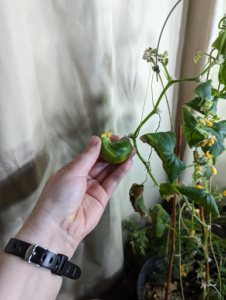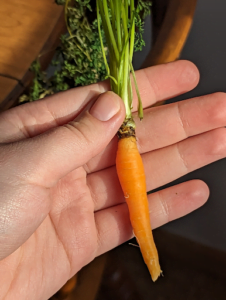
Spring is right around the corner and I am counting down the days until I can put my space heater away. Punxsutawney Phil, the groundhog of Groundhog’s Day, predicted an early spring this year and I sure hope he’s right! But why wait for spring? It is already plenty warm enough indoors to start seeds for my little garden.
Last year I heard about the seed library for the first time as a new employee. Although my resources were limited, I took some seed packets and, through trial and error, learned a great deal about gardening with limited space and funds. Here is my advice.
Growing with limited space
Grow in pots
If you have a landlord like mine they may not be too fond of you digging up holes in the yard of the building you rent to plant your seeds. But do you have a patio? a balcony? a front porch? or even a doorstep? These are all perfect places to put a potted plant. Since I do not have a yard to use, I grow my garden in pots. They can be moved from indoors to outdoors, stacked on shelves, and used as decoration. This avoids the mess of transplanting and does not require digging holes in your yard.
Try succession planting
This is the practice of planting new seeds in between established plants of the same kind. For example, radishes grow quickly. If you plant a new row of radishes every ten days, you will have continuous radishes ready to eat! This method can be used indoors or outdoors and is especially useful for plants that are harvested whole such as carrots, radishes, onions, beats, or even annual flowers such as zinnias and sunflowers.
Grow your climbing things vertically


Many fruiting plants love to vine far and wide–beans, squashes, melons, cucumbers, and peas are just a few. If you are lacking space for them to climb along the ground, you can encourage them to grow vertically. My initial goal when I started my little indoor garden was to grow my own cucumbers. I planted five seeds that I got from the seed library. I ended up with two cucumber plants that grew slowly but steadily. Since I did not have room for them to grow along the ground I gave them sticks to climb up instead. I only got one teeny tiny cucumber off of my plants last year but I will soon try again now that I have supplemental lighting.
Speaking of supplemental lighting, you can garden indoors with grow lights.
Once it became obvious that the light coming through my small window was not enough for my plants to thrive, I started researching grow lights. I purchased a pack of LED grow light bulbs and put them in a lamp that was plugged into an extension cord with a timer. Thanks to the timer my plants automatically get consistent light without me having to remember to turn the lights on and off each day. Other methods I read about include replacing overhead light bulbs with grow light bulbs or using shop lights as grow lights. However, supplemental lighting can be completely avoided by growing your garden outdoors, putting your plants in a window that gets plenty of sunlight, or growing low-light plants.
Growing with a limited budget
Grow hydroponically
Dirt can be obtained from the nursery of almost any big box store, although it may not be dirt cheap. Or, it can be harvested from your very own backyard if you happen to have one. But if you don’t have dirt you can still grow in water, this is called hydroponics. Lettuce and green onions are easygoing plants that will be perfectly happy to grow in a cup of water with some fertilizer.
Regrow from food scraps
The stump of a head of lettuce, the bottom of a bunch of celery, or the white of a green onion can be placed in water or dirt to regrow. This can be done with larger plants as well. Avocado pits can be grown into avocado trees and pineapple tops can be grown into large pineapple plants that will produce a new pineapple in approximately two years. Although, you should keep in mind that the larger the plant is the more time and space they will require.
Try duplicating plants you already have
You can clone your plants through propagation or collect seeds from mature plants. I harvested some seeds from old marigold blooms last year so that this year I can grow them again. Many house plants such as succulents and pothos are very easy to propagate from cuttings.
Use what you have


Unfortunately, I used to be a notorious houseplant killer. Fortunately, this left me with several pots of dirt to use for my new plants. I had some fertilizer I had bought for my peace lily before it gave up the ghost. I was nervous to use it on my zinnias and marigolds since I had heard (from who knows where) that using the wrong fertilizer would encourage leaf production rather than blooming. However, I eventually went ahead and gave them the “wrong” fertilizer and within two weeks there were buds!
So take a look around at what you do have. If you have room in your yard you can start composting to turn plant waste into nutritious soil. Or if you have an extra bucket or trashcan you can use it as a rain barrel to collect water for your garden. Using what you have includes items that are trash. Disposable containers you have lying around can be used to start seeds in. I start all of my seeds in used packaging I would otherwise throw away such as sour cream containers or egg cartons.
Use your free resources


The two free resources that have helped me the most are Google and the Seed Library here at Salina Public Library. Google can provide you with a wealth of free information so make sure to do your research. I thought growing carrots indoors would be easy. But after picking and washing my very first carrot, I took a bite only to find that it was extremely bitter! A quick Google search then informed me that carrots need cold temperatures to encourage the storage of sugar in their roots. I put my carrot pot outside for a few cold days and the rest of the carrots were much sweeter.
This year is the fourth season of the Seed Library at Salina Public Library. The Seed Library is a collection of free seeds available to everyone. So stop by the library and pick up some seed packets from the drawers by the north entrance across from the circulation desk. There are a variety of fruit, vegetable, and flower seeds available now through the end of June. Each person may take up to three seed packets per day. What will you grow?

About The Author: Moriah
Moriah is a Clerk in the Youth Services Department. She is from Texas but is currently residing in Salina to attend Kansas State University - Salina where she is in the Professional Pilot program working on a Bachelors of Aeronautical Technology. When she is not in class, flying, working, or studying, she likes to work on her indoor garden, cook, and dabble in a variety of crafts.
More posts by Moriah